G.Sargent–S.McWhirter
Route 20 Chess Club
Freeport, Illinois, May 18, 2010
1.e4 e5 2.Nf3 Nc6 3.d4 d6?
3.d4 is the Scotch Game. The standard answer is 3...exd4; "3...d6 gives a bad Philidor," Sam Collins dryly says in Understanding the Chess Openings, "with the knight committed to c6." (The Philidor Defense is 1.e4 e5 2.Nf3 d6.)
4.dxe5?
That being said, Gary's response to Steve's out-of-book move is also suboptimal. 4.Bb5 is more heavily favored, 4.Nc3 a bit less so.
4...Bg4 5.exd6 Bxf3 6.Qxf3 Qxd6
Gary seizes his opportunities and stands a pawn up.
7.Bc4 Qb4+ 8.Qc3 Nf6 9.a3 Qe7 10.0-0
Relinquishes the pawn advantage -- black's natural answer is 10...Nxe4. 10.f3 holds the line for white.
10...0-0-0
Not awful -- black's second-best move, actually -- but why pass up material equality when you're down?
11.Bg5
It's like Gary is asking Steve to take his pawn . . .
11...Rd4?
. . . and Steve is saying, "No, really, I couldn't"! (Although with his knight pinned, black now has to take with his queen, allowing white to swipe another pawn with 12.Bxf7.)
12.Bd5
What's the idea of this move -- to box in black's rook somehow? Gary has many better ways to tighten the screws on Steve, for instance, 12.Nd2 Nxe4 13.Qxd4 Nxd4 14.Bxe7 Nxd2 15.Bxf8 Rxf8, winning the exchange and clearing the center for cannon fire. There's even the cheap shot 12.Qh3+.
12...Qc5?
So much for an attack on e4. Steve should strike immediately with the gonzo 12...Nxd5 13.exd5 Qxg5 14.dxc6 Bc5.
13.Bxf6 Qxc3 14.Nxc3
Gary hasn't lost his decisive advantage, but contemplate the situation after the wicked 14.bxc3!: with a jab at black's rook, white gains time to evacuate his bishop from f6, leaving him a piece and a pawn up. Which just goes to show that Steve should have played 13...gxf6 instead of trading queens (something he should have avoided anyway, being down in material).
14...gxf6 15.Bxf7 Bd6 16.Nb5
16.Rad1!? challenges black's control of the open d-file.
16...Rxe4 17.Nxd6+ cxd6 18.Bd5
18.Rae1 Re7 19.Rxe7 Nxe7 looks good too. Even trades favor Gary right now.
18...Re2 19.Bxc6
The trouble with this, rather than an immediate Rac1!? (or the less favorable Rfc1), is that it throws away an active piece and gives Steve's pawns space and mobility. With nothing but rooks, kings and pawns in the field -- and with a black rook already on its seventh rank, while both white rooks are still on their first -- Gary's one-pawn material advantage looks a lot less significant.
19...bxc6
20.Rac1 Kd7 21.h3 a5
The open b-file and e-file are calling to Steve's undeveloped rook, but it doesn't hear.
22.Rfe1 Rd2 23.Kf1 Rb8 24.b3 Rb5 25.Re2 Rxe2 26.Kxe2 Re5+ 27.Kf1 h5 28.Re1 Rc5
With precise endgame play, Steve is keeping Gary from taking advantage of his extra pawn.
29.Re2 f5 30.a4 Rd5 31.Ke1 h4 32.Rd2 Re5+ 33.Kd1 Re4 34.Rd3 Rf4
Steve's first stumble in many moves, blockading his own f-pawn. Better to advance it.
35.Rf3
Gary repays the favor. 35.Ke2 seizes a chance to break out: 35...c5 36.c4 Re4+ 37.Kf3.
35...Rxf3 36.gxf3 f4
The door is slamming on Gary's winning chances. His extra pawn is useless now, trapped behind its compadre.
37.Kd2 c5 38.c4 Ke6 39.Kd3 Ke5 40.Kc3
40...d5??
A disastrous choice. Steve's best bet is to maintain the deadlock, and claim the draw, with a king move. Instead, the dominoes fall:
41.cxd5 Kxd5 42.Kd3 c4+?! 43.bxc4+ Kc5 44.Kc3! Kd6 45.Kd4 Kc6 46.c5 1-0
If Gary's c-pawn doesn't promote, his a-pawn will.

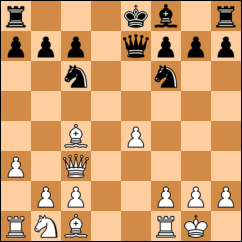
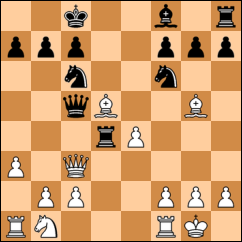
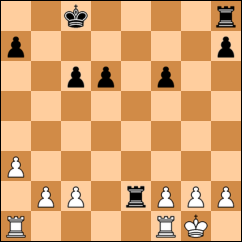
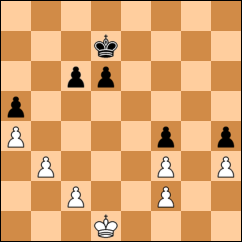
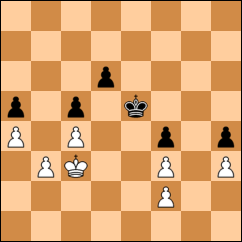



1 comments:
note from Gary:
The clock is missing from this analysis; we were near "closing" time and therefore playing at G-20. I anticipated a pawn ending, and several of my moves, including 4. de?, were aimed toward this.
By move 12 Steve was in time trouble; by move 19 his flag was hanging, while I still had over 10 minutes. The (half-)open files that Keith recommends for Steve at this time were countered by my better pawn structure and large time advantage.
Steve's 40... d5?? was a desperation move to avoid time forfiet.
Post a Comment